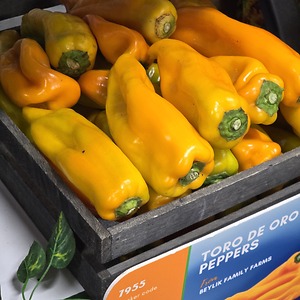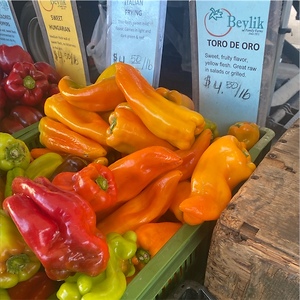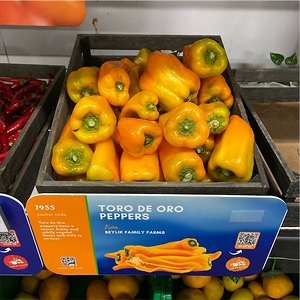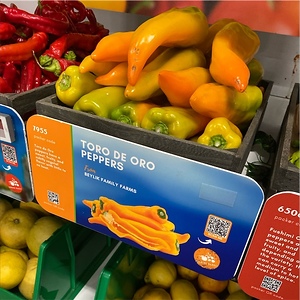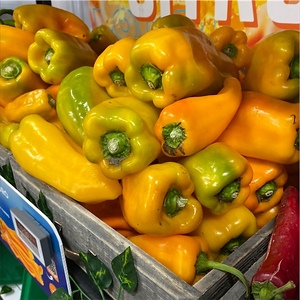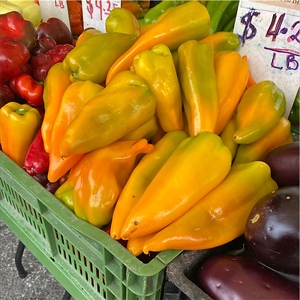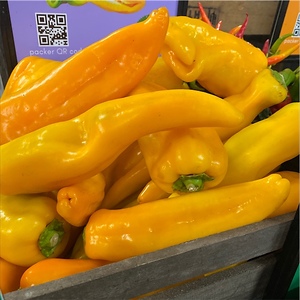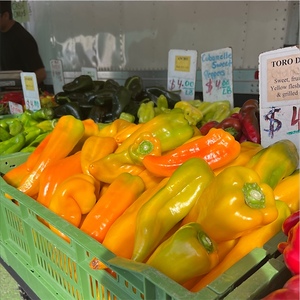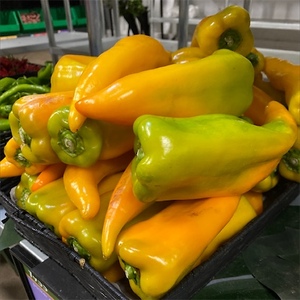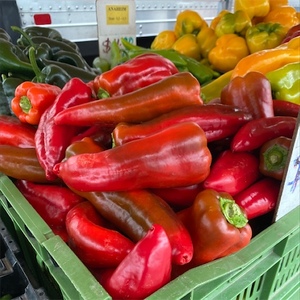

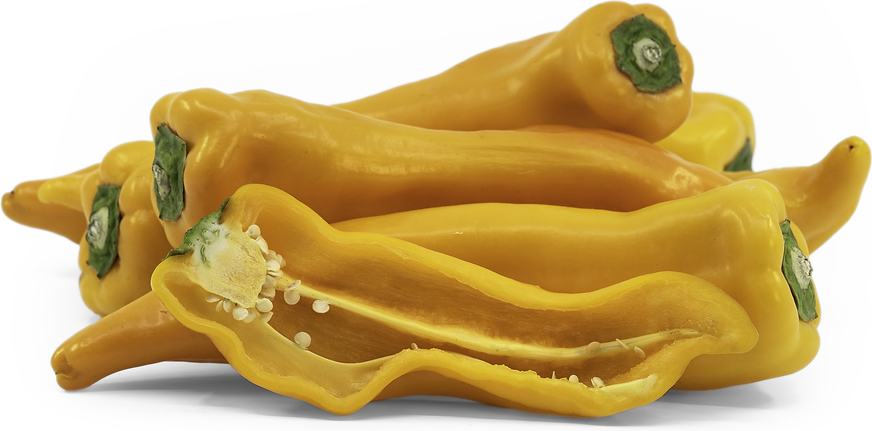
Toro de Oro Chile Peppers
Estimated Inventory, lb : 0
This item was last sold on : 10/03/24
Description/Taste
Toro de Oro peppers are an elongated chile variety that typically measures 15 to 20 centimeters in length and 2 to 6 centimeters in width. They ripen from green to golden yellow and may be streaked with hints of green when mature. Toro de Oro peppers usually have three lobes with a conical shape that tapers to a slight point on the non-stem end. Their skin is smooth, glossy, thin, and lined with vertical indentations. The striated flesh of these peppers is thick, crisp, aqueous, and pale green to yellow depending on maturity. Within the flesh is a central hollow cavity encasing a membrane with small, round, and flat cream-colored seeds. Toro de Oro peppers have a sweet, fruity, and subtly vegetal flavor with little to no heat.
Seasons/Availability
Toro de Oro peppers are available from summer to early fall.
Current Facts
Toro de Oro peppers are botanically classified as Capsicum annuum and belong to the Solanaceae family along with eggplants, potatoes, and tomatoes. They are a rare sweet pepper variety that was developed by Beylik Family Farms in Ventura County, California. Toro de Oro pepper’s name originated from the fact that they are similarly shaped to a bull’s horn. They may be mistakenly called Bull’s Horn sweet peppers but this is actually a nickname for another type of chile pepper called Corno di Toro. This alternate variety has a similar appearance and sweet flavor to Toro de Oro peppers but primarily comes in red and orange rather than just yellow. Toro de Oro peppers are an open-pollinated variety that has little to no heat. They rank from 0 to 100 SHU on the Scoville scale for ranking the hotness of a pepper. This variety is primarily cultivated for its mild flavor that’s able to be used in a wide array of culinary applications.
Nutritional Value
Toro de Oro peppers are an excellent source of vitamin C that can help boost the immune system, lower bad cholesterol levels, and aid in collagen production, iron absorption, brain function, and skin and heart health. This variety is also a source of potassium, manganese, and folate. These nutrients improve muscle and nerve function, fluid balance, bone development, metabolism, wound healing, cell growth, and red blood cell formation. The fiber in Toro de Oro peppers encourages proper digestion, regular blood sugar and cholesterol levels, weight management, and inflammation reduction. This variety also provides the body with vitamin B6 to boost serotonin and dopamine levels that regulate mood and may alleviate nausea during pregnancy.
Applications
Toro de Oro peppers have a sweet and mild flesh that's suited for both raw and cooked applications. These peppers can be consumed fresh out-of-hand as a snack or served as an accompaniment to dips on appetizer plates. They can also be chopped and tossed into green salads or diced into salsas. In addition to fresh applications, Toro de Oro peppers are commonly stuffed with grains, cheeses, and meats. They may be baked, blistered, and blended into sauces or roasted and added to soups, stews, and chilis. These vegetables are frequently sautéed in pastas and risottos. Toro de Oro peppers pair well with poultry, turkey, pork, beef, eggplant, garlic, shallots, potatoes, tomatoes, cabbage, herbs such as parsley, cilantro, basil, and oregano, cheeses like parmesan, cheddar, or mozzarella, and grains such as rice, couscous, and quinoa. They will keep up to one week when stored whole and unwashed in a paper or plastic bag in the refrigerator.
Ethnic/Cultural Info
The specialty pepper market has become increasingly popular among consumers and chefs in the United States. Farmers and breeders have been encouraged to continually produce hybrid varieties with improved flavor, appearance, and growth characteristics. Many heirloom Italian frying peppers have been used in the breeding process of new American peppers. There was also a resurgence of heirloom and open-pollinated varieties that were previously reserved for select specialty growers and personal gardeners. Toro de Oro peppers are one of the best-looking and tastiest mild peppers to come out of this age of expansion.
Geography/History
Toro de Oro peppers are exclusively grown and sold by Beylik Family Farms in the fertile Santa Clara River Valley of Ventura County, California. The seeds of this golden variety were first acquired by Scott Beylik, owner of Beylik Family Farm, in the late 20th century. Beylik received the seeds from one of his regular seed breeders who informed him that they were from an open-pollinated variety. Toro de Oro peppers were first introduced to the market in the early 21st century. They can be seasonally spotted at various farmer’s markets across Southern California from Santa Barbara to Los Angeles.



